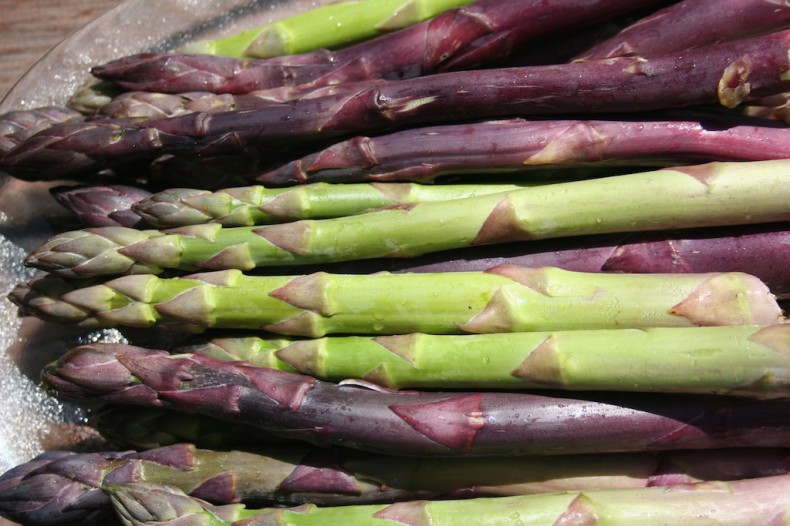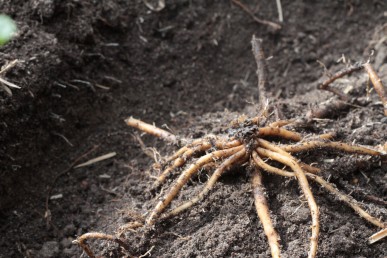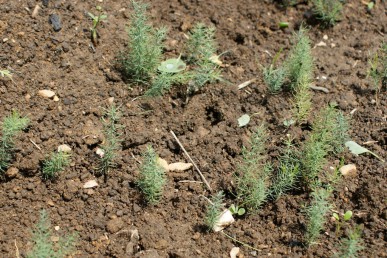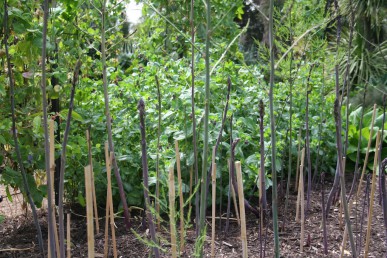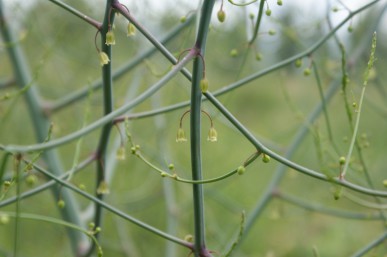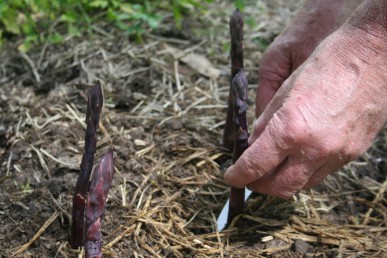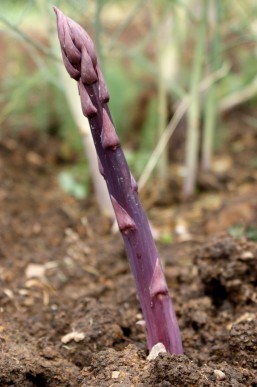by Penny Woodward
Asparagus (Asparagus officinalis) is a tough, rewarding, long term vegetable that once established will give many years of delicious, nutritious spears. A perennial plant, it is a member of the lily family (Liliaceae) and has been grown and eaten for more than 2,000 years. If you haven’t ever tried growing asparagus, you probably should, and now is a good time to plant it.
Preparation
The key to really good production is soil preparation and as asparagus can go on producing for twenty years it is worth doing it properly. A friend who grew asparagus for more than 50 years said that her best crop came from the bed she planted over the burial site of her favourite horse! Choose a site with open friable soil and good drainage in a sunny position. If the soil is too heavy then establish mounds or a raised bed. Add a borrow load of manure and compost to every 2 square metres of soil and sprinkle several handfuls of dolomite over the top. Asparagus likes a ph of about 7. Dig the soil well and leave to sit for a few weeks. Remove any weeds as asparagus does not like competition.
Seed or Crowns?
Asparagus can be grown by planting seed or by purchasing and planting crowns. Seed germinates fairly readily but it can take from 2-4 weeks before the seedlings appear and I have found the best way to grow it from seed is to plant into large tree tubes. I fill these with potting mix except for the last two centimetres, which I make up with seed raising mix. Soak the seed in warm water overnight, water the pots well and plant two or three seeds into each pot, water again. Line a polystyrene box with plastic sheet and fill the bottom with about 3 cm of river sand. Moisten the sand. Stand the pots in the sand and move the whole box into a position out of direct sunlight. Keep the sand moist and the pots will stay moist by drawing water from the sand. Once the seeds germinate, remove extra seedlings so that only one remains. Leave these seedlings to grow, produce ferns and then die back.
Crowns are generally purchased in winter and spring and planted out straight away.
Timing
The time to plant seeds, seedlings and crowns depends on your climate. Asparagus spears are frost sensitive but it is otherwise a very adaptable vegetable and is grown from cool temperate regions to the sub-tropics. It is also grown in the tropics, but yields are not as prolific and plants do not last as long. Plant seed from late September to November in cool regions with frosts, from March to September in frost-free temperate and sub-tropical regions and May to July in the tropics. Transplant seedlings and plant out crowns in mid spring in frosty regions, from late autumn to mid spring in frost-free temperate and sub-tropical regions and in autumn and early winter in the tropics.
Planting
A single row of asparagus generally results in a longer and more prolific crop because there is less over-crowding. So dig a trench, about 20 cm deep and 30 cm wide, into the already prepared bed and plant the crowns or seedlings 40 cm apart. Extra rows need to be 120 cm apart. For crowns, make small mounds in the trench and spread the roots over the mound so the roots are at an angle of about 45 degrees. Plant seedlings straight into the trench. Back fill with a mixture of soil and compost so there is about 8 cm of soil over the crown, but the trench is still about 10 cm deep. Water well and mulch lightly with pea straw or sugarcane mulch. Mulching can delay the appearance of spears by keeping the soil cooler, but will extend the harvest at the other end of the season. The delay in appearance is a good thing in frosty areas because the early spears are less likely to be damaged by frost.
Ongoing care
Do not harvest any spears in the first year after planting, just allow the spears to grow and ferns to develop, flower and set seed. This means that all the nutrients go back to the roots to keep them strong and help the plants to establish. Ferns can reach a height of 1.5 metres so might need some protection from wind. Every year when the spears start to appear, top dress with blood and bone and protect from snails and slugs. Remove weeds and keep well watered to encourage strong root growth. Asparagus plants are dioecious, which means there are male and female plants. Female plants will produce red fruit in autumn and these fruit should be removed when they appear (unless you want to collect seed) or you may have hundreds of seedlings to weed out later in the year. Some growers advocate removing female plants, believing that they are less prolific. In reality the spears from female plants tend to be thicker but less prolific while male spears are thinner, sometimes too thin, but more prolific. In late autumn the ferns will turn brown and should be cut back to a few centimetres above the soil. Top dress the bed with well rotted manure and mulch with a thick layer of pea straw to keep weed growth to a minimum. My sister, who grows a lot of asparagus, lets the chooks in to fertilize and scratch amongst the plants once the ferns have been removed and only mulches later in the year. She also grows other vegetables, like tomatoes, in rows beside the asparagus. The compost and manure added to the tomatoes helps to feed the nearby asparagus.
Harvesting
In the second year after planting, spears will begin to appear in late winter and early spring and continue right through spring into early summer. The idea now is to harvest as many as you can, but leave enough to grow into ferns and replenish the rootstock so that you have strong healthy growth the following year. Some growers only harvest the thicker spears, leaving the thinner ones to grow ferns, these are sometimes called mother ferns. Others harvest all spears for six weeks to two months, and then start leaving some to grow ferns and after about three months let all grow into ferns.
In the third or fourth year after planting out, the asparagus will have reached its maximum yield and if properly maintained will continue to produce for another ten to fifteen years. After this, yields will start to decline.
In tropical regions, you can start harvesting in mid-June and continue through to the end of August. The lack of cold to induce winter dormancy means that plants don’t last as long as those grown in more temperate regions, although drought induced dormancy in autumn can sometimes work as a substitute.
Cutting
When harvesting spears, use a sharp knife and cut the spear when it is about 20 cm long, a couple of centimeters below the surface of the soil. During the height of the season, spears grow much more quickly and in very warm humid conditions can grow more than 2 cm in an hour!
Nutrients
Asparagus is a nutritional powerhouse containing many of the B vitamins as well as vitamin C and other anti-oxidants, potassium, and small amounts of iron. Fresh spears can be eaten straight from the garden or cooked briefly by baking, boiling, steaming, frying or even barbecuing. Finally, if you are one of about 60% of people who’s urine smells funny after eating asparagus, you might like to know that it comes from a chemical called asparagusic acid which metabolises with other chemicals in your body to produce the characteristic smell.
Varieties available
Green
‘Mary Washington’ is the most common cultivar of asparagus, in both seed, seedlings and crowns. It is high yielding with green spears and rust resistance.
‘Conovar’s Collossal’ is a very old cultivar with thick dark green shoots. Only available in seed.
‘Fat bastard’ an F1 male hybrid with fatter than normal spears. Rust resistant.
UC157 F1 hybrid This green cultivar is the best for tropical regions. Only available as seed.
Purple
Most of the purple cultivars sold in Australia for home gardeners are just called Purple, or sometimes Sweet Purple or Purple Passion.
The purple colour comes from anthocyanin pigment in the stem. Purple asparagus has a high sugar content, so has a mild, sweet taste.
White
White asparagus is just green asparagus grown without light. This can either be achieved by continually mounding soil up around the spear so that it doesn’t break the surface of the soil. Alternativley it can be grown in a polytunnel covered in black plastic to exclude all light. White asparagus is regarded as a delicacy and can be very expensive to buy but I think green and purple asparagus taste much better and doubt that white asparagus is worth the extra effort.
Contacts
For extra information and great recipes go to the Australian Asparagus Council website
Crowns can be purchased from your local nursery in winter and early spring.
Mail order seedlings and seeds can be ordered from
Diggers, PO Box 300, Dromana, Vic, 3936. www.diggers.com.au
Green Harvest, PO Box 92, Maleny Qld 4552 www.greenharvest.com.au
Four Season’s Herbs, PO Box 110, Exeter, Tas. 7275.www.fourseasonsherbs.com.au
Seeds can be ordered from
New Gippsland Seeds and Bulbs, PO Box 1, Silvan, Vic, 3795 www.newgipps.com.au
Edens Seeds, M.S. 905, Lower Beechmont, 4211 www.edenseeds.com.au
The Lost Seed, PO Box 321, Sheffield, Tas. 7306. www.thelostseed.com.au

